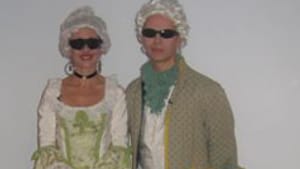Stay in the Loop
BSR publishes on a weekly schedule, with an email newsletter every Wednesday and Thursday morning. There’s no paywall, and subscribing is always free.
'Mozart Reloaded': A composer for all seasons

LEWIS WHITTINGTON
The accomplished Philadelphia pianist Andrea Clearfield is known for the tony salons that showcase contemporary classical composers and musicians in her Center City loft. Presumably for that reason, the Kimmel Center asked her to commemorate Mozart's 250th birthday by assembling a concert featuring local musicians and composers who would "re-imagine" (Clearfield's phrase) the composer according to their various disciplines.
Clearfield delivered the goods with a concert billed as "Mozart:Reloaded," a fresh, irreverent, raucous and ultimately joyous event that celebrated Mozart in a unique way. Clearfield (decked out in mile-high powered wig and Marie Antoinette drag) introduced each piece and proved a gracious curator/host for the evening.
"Mozard Reloaded" actually got started on a wrong note by composer Uri Caine - but his fast fingers worked the flub in like a deliberate misfire to introduce his "Improvisation on Themes from Mozart's Piano Sonata in C Major." Caine then seguéd everywhere on the Steinway from a Mozartized mazurka to a silent screen slide. Actually, Liberace used to do the same trick in Vegas, but Caine's essay wasn't mere ostentatious finger work; it demonstrated the theme for the evening as he stated it: that Mozart thrives in any musical setting.
An early highlight of the concert came in the next group, the Tony Miceli Quartet, featuring entrancing vocals from Joanna Pascale in jazz treatments of two Mozart arias from The Marriage of Figaro. Pascale was vocally commanding Miceli in "Ridenti la calma," displaying a sonorous lower register and unfussy phrasing reminiscent of Nina Simone. "Voi, che sapete" lent itself less to Pascale's contralto prowess, keeping her in a plaintive middle range, but the piece otherwise framed Miceli's galloping vibe solo like a little slice of jazz heaven.
Violinist Gloria Justen took the stage next in a sequined lamé ensemble for a bit of storytelling a la "Peter and the Wolf." The story, "Foxy Lady and the Magic Box: A tale told with string accompaniment,"' was penned by Justen, who also performed the pre-recorded violin tracks. The recording was willing but the live action was weak. Lost in Justen's cutesy story and under-rehearsed mugging was some witty bow work. Note to Justen: Quit playing around and just play.
While the stage was being set for a dance piece, accordionist extraordinaire Lydia Kaminska made a surprise appearance, decked out in a velvet maroon '60s Oscar de la Renta-style pantsuit, pumping out some Mozart de la tango.
Manfred Fischbeck's Group Motion dancers, looking like a ragtag band of troubadours in desiccated renaissance drag, staggered onstage as escapee characters from The Magic Flute in a work titled "An Unveiling." The five dancers proceeded to embark on a hilarious dance satire of the beatification and corruption of Mozart as the artistic ideal.
Audio-video mixer Peter Price scored Fischbeck's choreography by scratching the Magic Flute overture, with deliberate skips, repeats and distortions. Fischbeck has worked frequently with multi-media, and Price's film montage (part John Waters, part Classic Arts Showcase) was projected on a fabric scrim positioned mid-stage. At times the dancers were completely integrated into the scenescapes. The film element here builds a choreographic plastique wrapped in sarcastic tableaux of movement friezes. After each dancer's self-possessing solo, Fischbeck moved them in joyously communal circles.
Intermission was followed by the premieres of four piano commissions by local composers. Each required that the piece be built off of the five-note ascending scale from the Birdcatcher's theme in The Magic Flute. Pianist Charles Abramovic, who performed in a Philadelphia Orchestra concert earlier the same evening in Verizon Hall, vividly articulated each work. After playing the classical version of the piece, he launched into the variations, starting with Sebastian Chang's On the Road, which darkly echoes Mozart's playfulness.
Next, Jan Krzywicki's Vogelfãnger evoked a cascading stillness, and Evan Solot's No Flutes Allowed was derivative of both Debussy and Leonard Bernstein, but past that distraction was pleasant enough.
It was left to Robert Maggio's Love bird to best fulfill Clearfield's mission of a "musical adventure'"of Mozart's music, forging tonal structures that were both unexpected and riveting. Maggio frequently scores contemporary ballet, and that influence was heard here. Rich melodic arabesques and picturesque passages broke away to crowded basso phrases and maniacal keyboard runs. There were segments where Abramovic reached over and played the piano's metal strings (actione?) with his hand. This was an eerie effect that drew you into Maggio's dramatic structure even more.
The Delaware Steel drum corps was an audience-pleaser, playing an original arrangement of the overture to— you guessed it— The Magic Flute. The 15 instruments together created a strange moog effect that left everyone humming to a spaced-out Mozart.
Lewis Whittington's articles on the performing arts have appeared in several publications, including the Philadelphia Inquirer, City Paper, The Advocate, Pointe, Dance Magazine and Metro. He lives in Center City.
Sign up for our newsletter
All of the week's new articles, all in one place. Sign up for the free weekly BSR newsletters, and don't miss a conversation.
